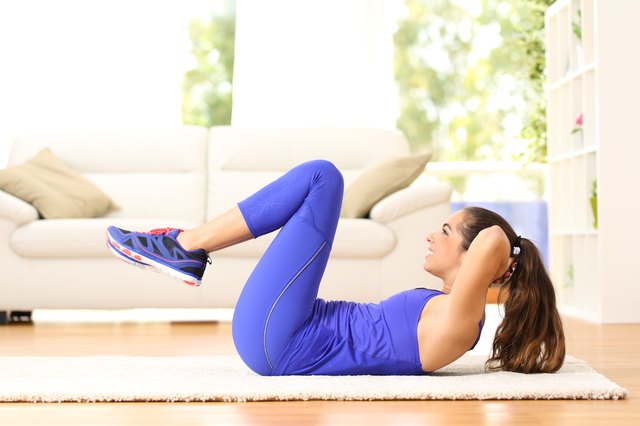Elbow-to-knee sit-ups are more than just another ab move—they’re a full-range core challenge that lights up your entire midsection. This dynamic sit-up variation blends twisting, lifting, and balance to hit your abs, obliques, and hip flexors all in one smooth motion. It’s a powerful way to build functional strength and sculpt a stronger core.
While the move might look basic, it works deep muscles that support your spine and help you move better in daily life. Whether you’re new to training or looking to shake up your core routine, elbow-to-knee sit-ups deserve a spot on your workout list.
What Are Elbow-to-Knee Sit-Ups?
This exercise is a variation of the traditional sit-up that adds a rotational twist. Instead of simply sitting straight up, you twist at the torso to bring one elbow across the body toward the opposite knee.
That twisting action brings your obliques into play, while the lift and crunch still hit your rectus abdominis—the “six-pack” muscle. The knee lift adds another layer of core control by involving your hip flexors. The result is a balanced, full-core movement that challenges your strength and coordination.
How to Do Elbow-to-Knee Sit-Ups Properly
- Lie on your back with your knees bent and feet flat on the floor.
- Place your fingertips lightly behind your ears. Keep your elbows wide.
- Tighten your core before you begin to lift.
- Exhale and crunch up, bringing your right elbow toward your left knee. Twist through your waist, not your neck.
- Lower back down slowly. Inhale as you return to the starting position.
- Repeat on the opposite side, bringing your left elbow toward your right knee.
Go slow and focus on each movement. Avoid pulling on your head or neck—let your abs do the work.
Muscles Worked During Elbow-to-Knee Sit-Ups
This exercise hits several major muscle groups:
- Rectus abdominis: Your front ab muscles responsible for spinal flexion
- Obliques: Side ab muscles that control rotation and side bending
- Hip flexors: Muscles that lift your knees and stabilize your pelvis
- Lower back: Engaged to balance and support spinal movement
You’re not just building strength—you’re improving balance, control, and posture.
Why This Move Boosts Core Stability
One major benefit of elbow-to-knee sit-ups is their ability to create real-world core strength. Unlike isolated crunches, this movement mimics actions you do daily—like bending, lifting, and twisting.
The more you challenge your body with this kind of rotational work, the better your core gets at protecting your spine and improving your overall movement. That’s why this move supports better posture and reduces injury risk.
Beginner-Friendly Modifications
If the full sit-up is too intense, start with easier variations:
One-Leg Crunches
Keep one foot on the ground while lifting the other knee. Reach across with the opposite elbow. This reduces the load but still works your obliques.
Crunch With Twist
Instead of a full sit-up, do a basic crunch and twist the upper body to reach one elbow toward the opposite side.
Partial Range Reps
Don’t sit up fully—just lift the shoulder blades and twist slightly. Build strength slowly over time.
Even beginners can use these variations to build foundational core strength.
Advanced Progressions for Core Challenge
Once the basic movement becomes easy, try these upgrades:
Weighted Elbow-to-Knee Sit-Ups
Hold a dumbbell or medicine ball near your chest as you twist.
Incline Sit-Ups
Perform the move on a sloped bench for added resistance.
Stability Ball Version
Lie on a stability ball instead of the floor. This adds an unstable surface that forces your core to work harder.
With these tweaks, you can keep progressing and avoid plateauing.
Common Mistakes to Avoid
A few errors can reduce the effectiveness of this exercise:
- Pulling on the neck: Always keep your hands light behind your ears
- Using momentum: Move slowly, and don’t throw yourself forward
- Skipping the twist: Make sure to rotate through your core, not just lift
- Feet lifting off the floor: Keep your feet grounded unless the variation calls for movement
Good form means better results and less risk of strain.
How to Add Them Into Your Routine
Here’s how you can structure your training with elbow-to-knee sit-ups:
Core Routine
Use them after planks, leg raises, and Russian twists to finish your ab day strong.
Circuit Finisher
Add them to a full-body circuit to bring in some core action with strength or cardio moves.
Weekly Goal
Aim for 3 sets of 12 to 15 reps per side, 2 to 3 times per week. Rest for 30 to 60 seconds between sets.
These sit-ups can fit almost anywhere in your workout and scale up or down depending on your level.
Tips for Better Results
- Exhale on the twist to engage your core deeply
- Keep elbows wide to reduce neck strain and ensure rotation
- Pair with cardio for fat-burning and better muscle definition
- Stay consistent—results come from regular effort, not random workouts
Also, pay attention to your nutrition. A strong core won’t be visible unless your body fat percentage is low enough.
Train Smarter With Technology
If you’re serious about results but struggle to stay consistent, apps like Dr. Muscle can help. It automates your workout plan, tracks progress, and updates routines as you get stronger. That means you spend less time guessing and more time getting real outcomes.
The Bottom Line
Elbow-to-knee sit-ups are a game-changer when it comes to full-core training. They combine strength, rotation, and control to work your abs, obliques, and hip flexors in one efficient move. Whether you’re aiming for better posture, visible abs, or improved performance in sports or daily life, this exercise delivers.
By using proper form, adding smart variations, and keeping it in your regular routine, you’ll build a strong, balanced core that supports everything you do.










